How Does the Urban Built Environment Affect Online Car-Hailing Ridership Intensity among Different Scales?
Abstract
:1. Introduction
2. Literature Review
3. Materials and Methods
3.1. Study Area
3.2. Data Source and Preprocessing
3.3. Methods
3.3.1. Indicator System of Urban Built Environment
3.3.2. Independent Variable Selection Based on Stepwise Regression
3.3.3. Ordinary Least Squares (OLS) Regression
3.3.4. Moran’s I Test
3.3.5. Geographically Weighted Regression
3.3.6. Multiscale Geographically Weighted Regression
3.3.7. Model Evaluation Metrics
4. Results and Discussion
4.1. The Global Regression Results Using the OLS Model in Different Scales
4.2. The Local Regression Results in Different Scales
4.3. The Spatial Variation in Coefficient Estimation by MGWR Model in Different Scales
5. Conclusions and Prospect
- (1)
- The built environment factors that significantly affect the intensity of the online car-hailing travel varied under different grid scales. As the grid size increases, the number of built environment factors that have significant effects on trip intensity decreased continuously.
- (2)
- From the 500 m grid to the 3000 m grid, there was always a positive effect of population density on the online car-hailing travel intensity. As the analysis scale increased, the effect of proximity to public transportation on the online car-hailing travel intensity shifted from an obvious inhibitory effect to a certain degree of facilitation. Meanwhile, the positive effect of land-use mix on the online car-hailing travel intensity was more and more significant. At the 500 m grid and 3500 m grid, road density had a positive effect on the online car-hailing travel intensity, but its effect was not significant at the remaining analysis scales. From the 500 m grid to the 4000 m grid, land-use type had both positive and negative effects on the online car-hailing travel intensity and showed different characteristics at different scales.
- (3)
- The results of the Moran’s I test for the OLS model residual indicated that there is spatial nonstationary in the effect of the built environment on the online car-hailing traveling intensity in the study area. By comparing the fitting results of involved models, it can be found that both the GWR model and the MGWR model can cope with spatial nonstationary better than the OLS model at almost all scales, and the performance of the MGWR model is better than that of the GWR model.
- (4)
- At different scales, the effects of built environment factors on the online car-hailing trip intensity showed different spatial variability characteristics. At various scales, the effect of population density on the online car-hailing trip intensity gradually decreased from north to south. The spatial patterns of the effect of road network density on the online car-hailing trip intensity include circling and wave patterns, in that the former is a characteristic at relatively fine scales while the latter at relatively coarse scales. The spatial variation in the effect of land-use mix on the online car-hailing trip intensity can only be identified more significantly at a relatively coarse scale. At the relatively fine and medium scales, the effect of bus stop density on the online car-hailing traveling intensity showed a wave-like pattern and a circle-like pattern. At the relatively coarse scale, the spatial variation in its effect was not obvious. The effect of various land-use types showed different spatial patterns at different scales, including wave-like pattern, circle-like pattern, and multi-core-like pattern. The spatial variation in the effects of various land-use factors gradually decreased with the increase in the analysis scale. It can be inferenced that different analysis scales may lead to different and even contrary conclusions.
Author Contributions
Funding
Institutional Review Board Statement
Informed Consent Statement
Data Availability Statement
Acknowledgments
Conflicts of Interest
References
- Szeto, W.Y.; Wong, R.C.P.; Yang, W.H. Guiding vacant taxi drivers to demand locations by taxi-calling signals: A sequential binary logistic regression modeling approach and policy implications. Transp. Policy 2019, 76, 100–110. [Google Scholar] [CrossRef]
- Nie, Y.M. How can the taxi industry survive the tide of ridesourcing? Evidence from Shenzhen, China. Transp. Res. Part C Emerg. Technol. 2017, 79, 242–256. [Google Scholar] [CrossRef]
- Zhang, B.; Chen, S.Y.; Ma, Y.F.; Li, T.Z.; Tang, K. Analysis on spatiotemporal urban mobility based on online car-hailing data. J. Transp. Geogr. 2020, 82, 102568. [Google Scholar] [CrossRef]
- Chuxing, D. Didi Chuxing Corporate Citizenship Report 2017. Available online: https://index.caixin.com/upload/didi2017.pdf (accessed on 28 March 2021).
- Handy, S.L.; Boarnet, M.G.; Ewing, R.; Killingsworth, R.E. How the built environment affects physical activity: Views from urban planning. Am. J. Prev. Med. 2002, 23, 64–73. [Google Scholar] [CrossRef]
- Wang, S.; Wang, J.; Li, W.; Fan, J.; Liu, M. Revealing the Influence Mechanism of Urban Built Environment on Online Car-Hailing Travel considering Orientation Entropy of Street Network. Discret. Dyn. Nat. Soc. 2022, 2022, 3888800. [Google Scholar] [CrossRef]
- Li, T.; Jing, P.; Li, L.C.; Sun, D.Z.; Yan, W.B. Revealing the Varying Impact of Urban Built Environment on Online Car-Hailing Travel in Spatio-Temporal Dimension: An Exploratory Analysis in Chengdu, China. Sustainability 2019, 11, 1336. [Google Scholar] [CrossRef] [Green Version]
- Ding, C.; Wang, Y.; Tang, T.; Mishra, S.; Liu, C. Joint analysis of the spatial impacts of built environment on car ownership and travel mode choice. Transp. Res. Part D Transp. Environ. 2018, 60, 28–40. [Google Scholar] [CrossRef]
- Cai, H.; Zhan, X.; Zhu, J.; Jia, X.; Chiu, A.S.F.; Xu, M. Understanding taxi travel patterns. Phys. A Stat. Mech. Its Appl. 2016, 457, 590–597. [Google Scholar] [CrossRef] [Green Version]
- Cervero, R.; Kockelman, K. Travel demand and the 3Ds: Density, diversity, and design. Transp. Res. Part D Transp. Environ. 1997, 2, 199–219. [Google Scholar] [CrossRef]
- Ge, W.; Shao, D.; Xue, M.; Zhu, H.; Cheng, J. Urban Taxi Ridership Analysis in the Emerging Metropolis: Case Study in Shanghai. Transp. Res. Procedia 2017, 25, 4916–4927. [Google Scholar] [CrossRef]
- Yang, Z.; Franz, M.L.; Zhu, S.; Mahmoudi, J.; Nasri, A.; Zhang, L. Analysis of Washington, DC taxi demand using GPS and land-use data. J. Transp. Geogr. 2018, 66, 35–44. [Google Scholar] [CrossRef]
- Ewing, R.; Cervero, R. Travel and the Built Environment: A Meta-Analysis. J. Am. Plan. Assoc. 2010, 76, 265–294. [Google Scholar] [CrossRef]
- Wang, M.; Mu, L. Spatial disparities of Uber accessibility: An exploratory analysis in Atlanta, USA. Comput. Environ. Urban Syst. 2018, 67, 169–175. [Google Scholar] [CrossRef]
- Xiao, Q.; He, R.; Yu, J. Evaluation of taxi carpooling feasibility in different urban areas through the K-means matter-element analysis method. Technol. Soc. 2018, 53, 135–143. [Google Scholar] [CrossRef]
- Li, B.; Cai, Z.; Jiang, L.; Su, S.; Huang, X. Exploring urban taxi ridership and local associated factors using GPS data and geographically weighted regression. Cities 2019, 87, 68–86. [Google Scholar] [CrossRef]
- Qian, X.; Ukkusuri, S.V. Spatial variation of the urban taxi ridership using GPS data. Appl. Geogr. 2015, 59, 31–42. [Google Scholar] [CrossRef]
- Xie, W.; Zhou, S. The Spatial-Temporal-Nonstationary Effect of Built-Environment on Taxi Demand. Mod. Urban Res. 2018, 11, 1336. [Google Scholar]
- Tang, J.; Liu, F.; Wang, Y.; Wang, H. Uncovering urban human mobility from large scale taxi GPS data. Phys. A Stat. Mech. Its Appl. 2015, 438, 140–153. [Google Scholar] [CrossRef]
- Zheng, Y.; Liu, Y.; Yuan, J.; Xie, X. Urban computing with taxicabs. In Proceedings of the 13th International Conference on Ubiquitous Computing, Beijing, China, 17–21 September 2011; pp. 89–98. [Google Scholar]
- Jiang, B.; Yin, J.; Zhao, S. Characterizing the human mobility pattern in a large street network. Phys. Rev. E 2009, 80, 021136. [Google Scholar] [CrossRef] [Green Version]
- Li, Z.; Chen, C.; Ci, Y.; Zhang, G.; Wu, Q.; Liu, C.; Qian, Z.S. Examining driver injury severity in intersection-related crashes using cluster analysis and hierarchical Bayesian models. Accid. Anal. Prev. 2018, 120, 139–151. [Google Scholar] [CrossRef]
- Liu, L.; Silva, E.A.; Yang, Z. Similar outcomes, different paths: Tracing the relationship between neighborhood-scale built environment and travel behavior using activity-based modelling. Cities 2021, 110, 103061. [Google Scholar] [CrossRef]
- Yu, H.; Peng, Z.-R. Exploring the spatial variation of ridesourcing demand and its relationship to built environment and socioeconomic factors with the geographically weighted Poisson regression. J. Transp. Geogr. 2019, 75, 147–163. [Google Scholar] [CrossRef]
- Yu, H.; Peng, Z.-R. The impacts of built environment on ridesourcing demand: A neighbourhood level analysis in Austin, Texas. Urban Stud. 2020, 57, 152–175. [Google Scholar] [CrossRef]
- Wang, M.; Chen, Z.; Mu, L.; Zhang, X. Road network structure and ride-sharing accessibility: A network science perspective. Comput. Environ. Urban Syst. 2020, 80, 101430. [Google Scholar] [CrossRef]
- Qiao, S.; Gar-On Yeh, A.; Zhang, M. Capitalisation of accessibility to dockless bike sharing in housing rentals: Evidence from Beijing. Transp. Res. Part D Transp. Environ. 2021, 90, 102640. [Google Scholar] [CrossRef]
- Dias, F.F.; Lavieri, P.S.; Garikapati, V.M.; Astroza, S.; Pendyala, R.M.; Bhat, C.R. A behavioral choice model of the use of car-sharing and ride-sourcing services. Transportation 2017, 44, 1307–1323. [Google Scholar] [CrossRef]
- Deka, D.; Fei, D. A comparison of the personal and neighborhood characteristics associated with ridesourcing, transit use, and driving with NHTS data. J. Transp. Geogr. 2019, 76, 24–33. [Google Scholar] [CrossRef]
- Kong, H.; Zhang, X.; Zhao, J. How does ridesourcing substitute for public transit? A geospatial perspective in Chengdu, China. J. Transp. Geogr. 2020, 86, 102769. [Google Scholar] [CrossRef]
- Wang, S.; Noland, R.B. Variation in ride-hailing trips in Chengdu, China. Transp. Res. Part D Transp. Environ. 2020, 90, 102596. [Google Scholar] [CrossRef]
- Sabouri, S.; Park, K.; Smith, A.; Tian, G.; Ewing, R. Exploring the influence of built environment on Uber demand. Transp. Res. Part D Transp. Environ. 2020, 81, 102296. [Google Scholar] [CrossRef]
- Cervero, R. Built environments and mode choice: Toward a normative framework. Transp. Res. Part D Transp. Environ. 2002, 7, 265–284. [Google Scholar] [CrossRef]
- Choi, K. The influence of the built environment on household vehicle travel by the urban typology in Calgary, Canada. Cities 2018, 75, 101–110. [Google Scholar] [CrossRef]
- Zhou, B.; Kockelman, K.M. Self-Selection in Home Choice:Use of Treatment Effects in Evaluating Relationship Between Built Environment and Travel Behavior. Transp. Res. Rec. 2008, 2077, 54–61. [Google Scholar] [CrossRef] [Green Version]
- Wu, C.; Ye, X.; Ren, F.; Du, Q. Check-in behaviour and spatio-temporal vibrancy: An exploratory analysis in Shenzhen, China. Cities 2018, 77, 104–116. [Google Scholar] [CrossRef]
- Bi, H.; Ye, Z.; Wang, C.; Chen, E.; Li, Y.; Shao, X. How Built Environment Impacts Online Car-Hailing Ridership. Transp. Res. Rec. 2020, 2674, 745–760. [Google Scholar] [CrossRef]
- Openshaw, S. A million or so Correlation Coefficients: Three Experiments on the Modifiable Areal Unit Problem; Pion: London, UK, 1979. [Google Scholar]
- Manley, D. Scale, Aggregation, and the Modifiable Areal Unit Problem. In Handbook of Regional Science; Fischer, M.M., Nijkamp, P., Eds.; Springer: Berlin/Heidelberg, Germany, 2021; pp. 1711–1725. [Google Scholar]
- Gao, F.; Li, S.; Tan, Z.; Wu, Z.; Zhang, X.; Huang, G.; Huang, Z. Understanding the modifiable areal unit problem in dockless bike sharing usage and exploring the interactive effects of built environment factors. Int. J. Geogr. Inf. Sci. 2021, 35, 1905–1925. [Google Scholar] [CrossRef]
- Anselin, L.; Griffith, D.A. Do spatial effecfs really matter in regression analysis? Pap. Reg. Sci. 1988, 65, 11–34. [Google Scholar] [CrossRef]
- Fotheringham, A.S.; Charlton, M.E.; Brunsdon, C. Geographically Weighted Regression: A Natural Evolution of the Expansion Method for Spatial Data Analysis. Environ. Plan. A Econ. Space 1998, 30, 1905–1927. [Google Scholar] [CrossRef]
- Brunsdon, C.; Fotheringham, A.S.; Charlton, M.E. Geographically Weighted Regression: A Method for Exploring Spatial Nonstationarity. Geogr. Anal. 1996, 28, 281–298. [Google Scholar] [CrossRef]
- Zhang, K.; Sun, D.J.; Shen, S.; Yi, Z. Analyzing spatiotemporal congestion pattern on urban roads based on taxi GPS data. J. Transp. Land Use 2017, 10, 675–694. [Google Scholar] [CrossRef]
- Yu, H.; Fotheringham, A.S.; Li, Z.; Oshan, T.; Wolf, L.J. Inference in Multiscale Geographically Weighted Regression. Geogr. Anal. 2019, 52, 87–106. [Google Scholar] [CrossRef]
- Li, Z.; Fotheringham, A.S.; Li, W.; Oshan, T. Fast Geographically Weighted Regression (FastGWR): A scalable algorithm to investigate spatial process heterogeneity in millions of observations. Int. J. Geogr. Inf. Sci. 2018, 33, 155–175. [Google Scholar] [CrossRef]
- Fotheringham, A.S.; Yang, W.; Kang, W. Multiscale Geographically Weighted Regression (MGWR). Ann. Am. Assoc. Geogr. 2017, 107, 1247–1265. [Google Scholar] [CrossRef]
- Ge, Y.; Jin, Y.; Stein, A.; Chen, Y.; Atkinson, P.M. Principles and methods of scaling geospatial Earth science data. Earth-Sci. Rev. 2019, 197, 102897. [Google Scholar] [CrossRef]
- Wolf, L.J.; Oshan, T.M.; Fotheringham, A.S. Single and Multiscale Models of Process Spatial Heterogeneity. Geogr. Anal. 2017, 50, 223–246. [Google Scholar] [CrossRef] [Green Version]
- Wu, C.; Ren, F.; Hu, W.; Du, Q. Multiscale geographically and temporally weighted regression: Exploring the spatiotemporal determinants of housing prices. Int. J. Geogr. Inf. Sci. 2019, 33, 489–511. [Google Scholar] [CrossRef]
- Sichuan Provincial Bureau of Statistics. Main Data of the Seventh National Census of Sichuan Province. Available online: http://tjj.sc.gov.cn/scstjj/c105897/2021/5/26/8c11fc9539a2458fb8c26831969dc2e7.shtml (accessed on 13 July 2021).
- China Transportation Department. Online Car-Hailing Supervision Platform Releases Industry Operation in February. Available online: http://www.gov.cn/xinwen/2021-03/22/content_5594771.htm (accessed on 13 July 2021).
- Palan, N. Measurement of Specialization—The Choice of Indices; FIW—Research Centre International Economics: Vienna, Austria, 2010.
- Moran, A.P.P. Notes on Continuous Stochastic Phenomena. Biometrika 1950, 37, 17–23. [Google Scholar] [CrossRef]
- Zhang, Z.; Li, J.; Fung, T.; Yu, H.; Mei, C.; Leung, Y.; Zhou, Y. Multiscale geographically and temporally weighted regression with a unilateral temporal weighting scheme and its application in the analysis of spatiotemporal characteristics of house prices in Beijing. Int. J. Geogr. Inf. Sci. 2021, 35, 2262–2286. [Google Scholar] [CrossRef]
- Akaike, H. A new look at the statistical model identification. IEEE Trans. Autom. Control 1974, 19, 716–723. [Google Scholar] [CrossRef]
- Munshi, T. Built environment and mode choice relationship for commute travel in the city of Rajkot, India. Transp. Res. Part D Transp. Environ. 2016, 44, 239–253. [Google Scholar] [CrossRef]
- Wh Ee Ler, D.; Tiefelsdorf, M. Multicollinearity and correlation among local regression coefficients in geographically weighted regression. J. Geogr. Syst. 2005, 7, 161–187. [Google Scholar] [CrossRef]
- Kupfer, J.A.; Farris, C.A. Incorporating spatial non-stationarity of regression coefficients into predictive vegetation models. Landsc. Ecol. 2006, 22, 837–852. [Google Scholar] [CrossRef]
- Crane, R. Cars and Drivers in the New Suburbs: Linking Access to Travel in Neotraditional Planning. Univ. Calif. Transp. Cent. Work. Pap. 1996, 62, 51–65. [Google Scholar] [CrossRef] [Green Version]
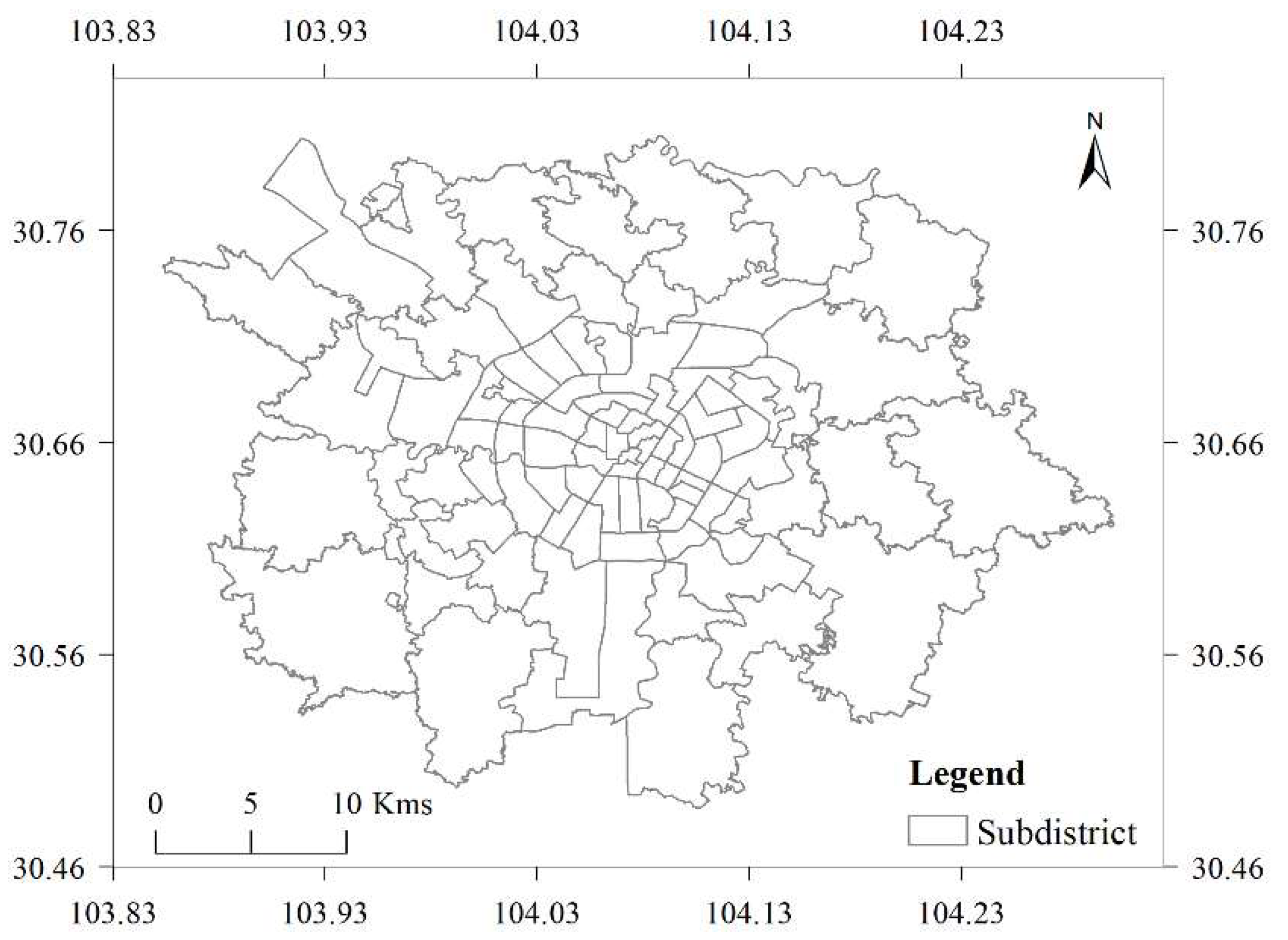
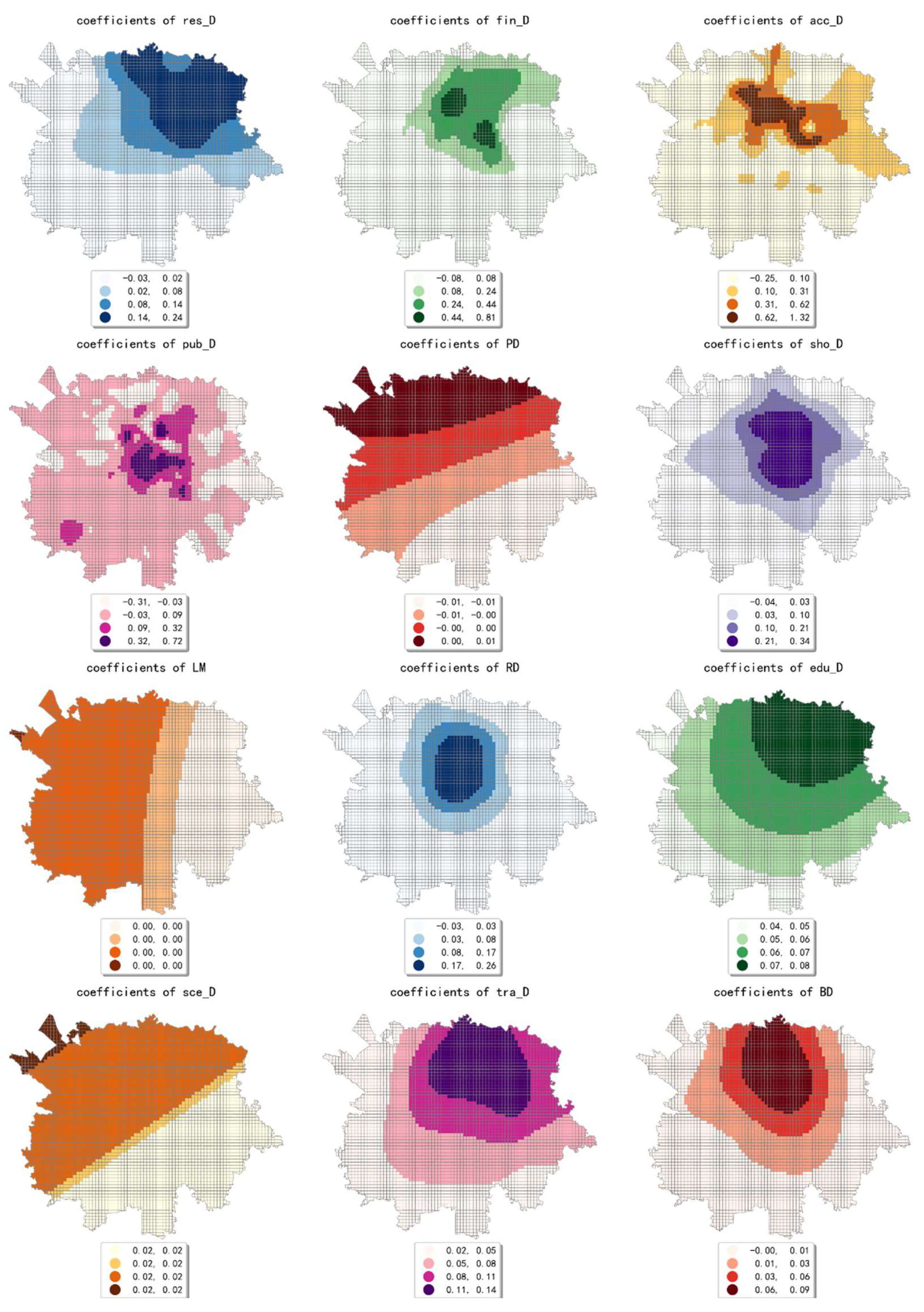

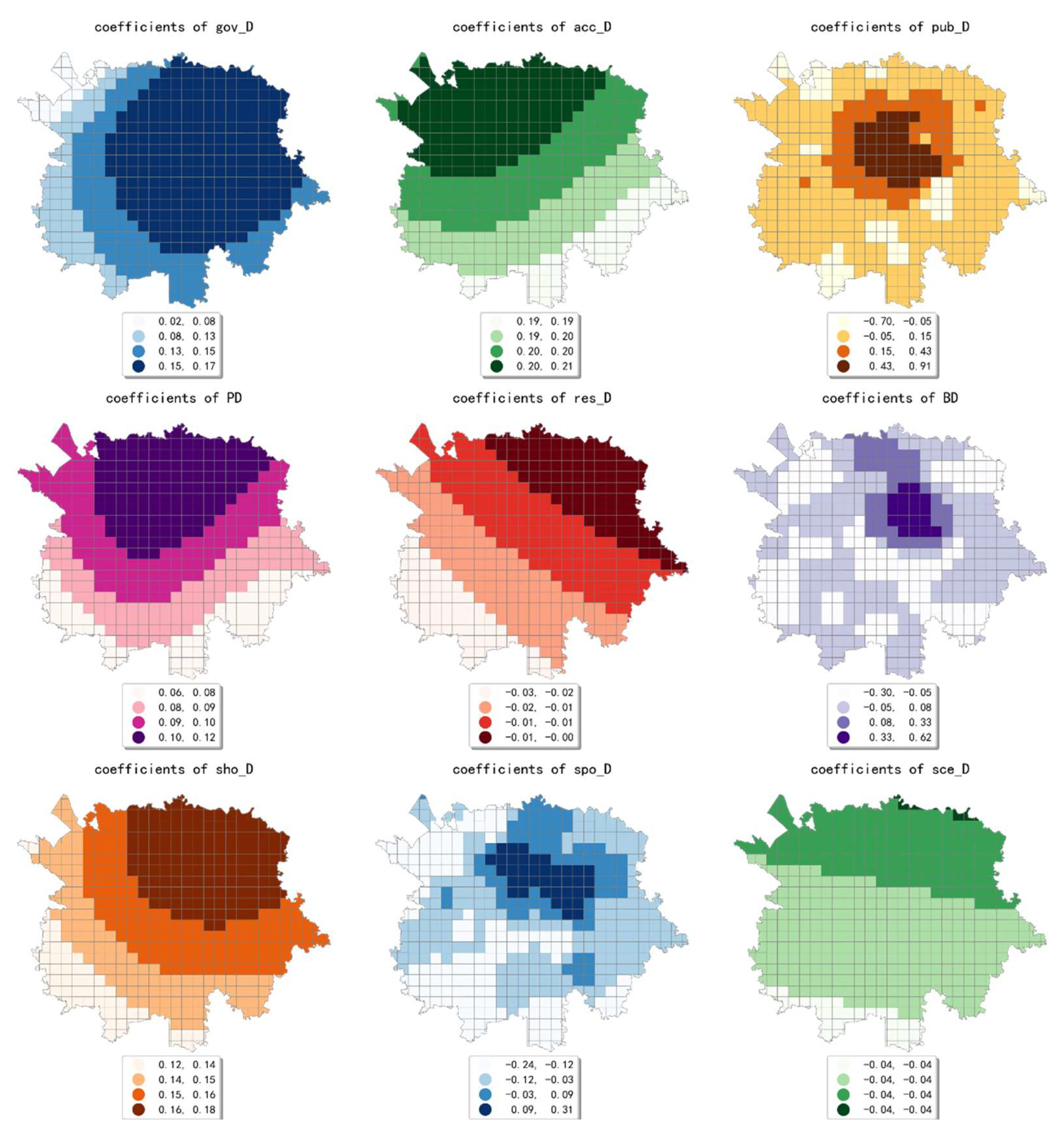
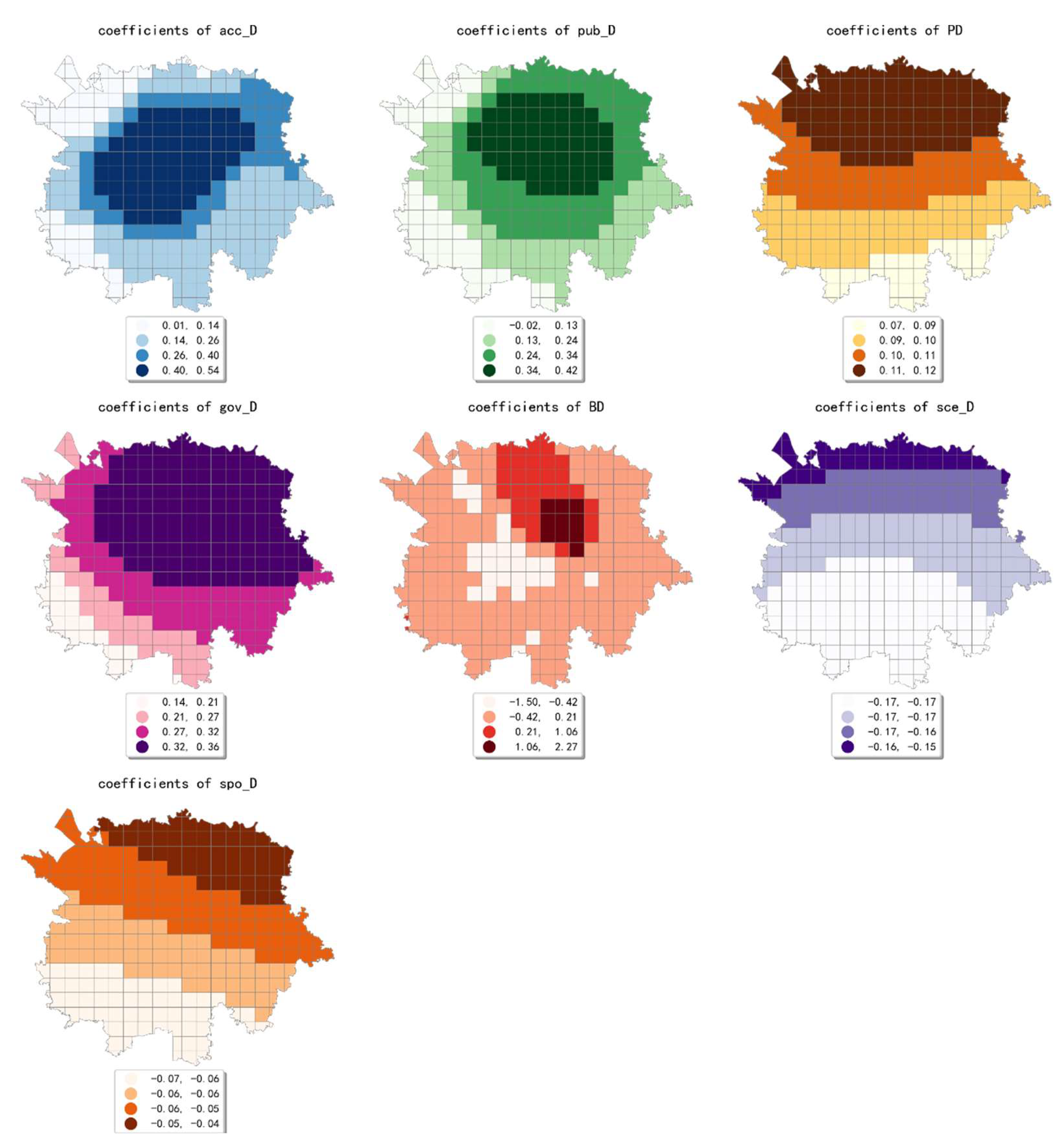
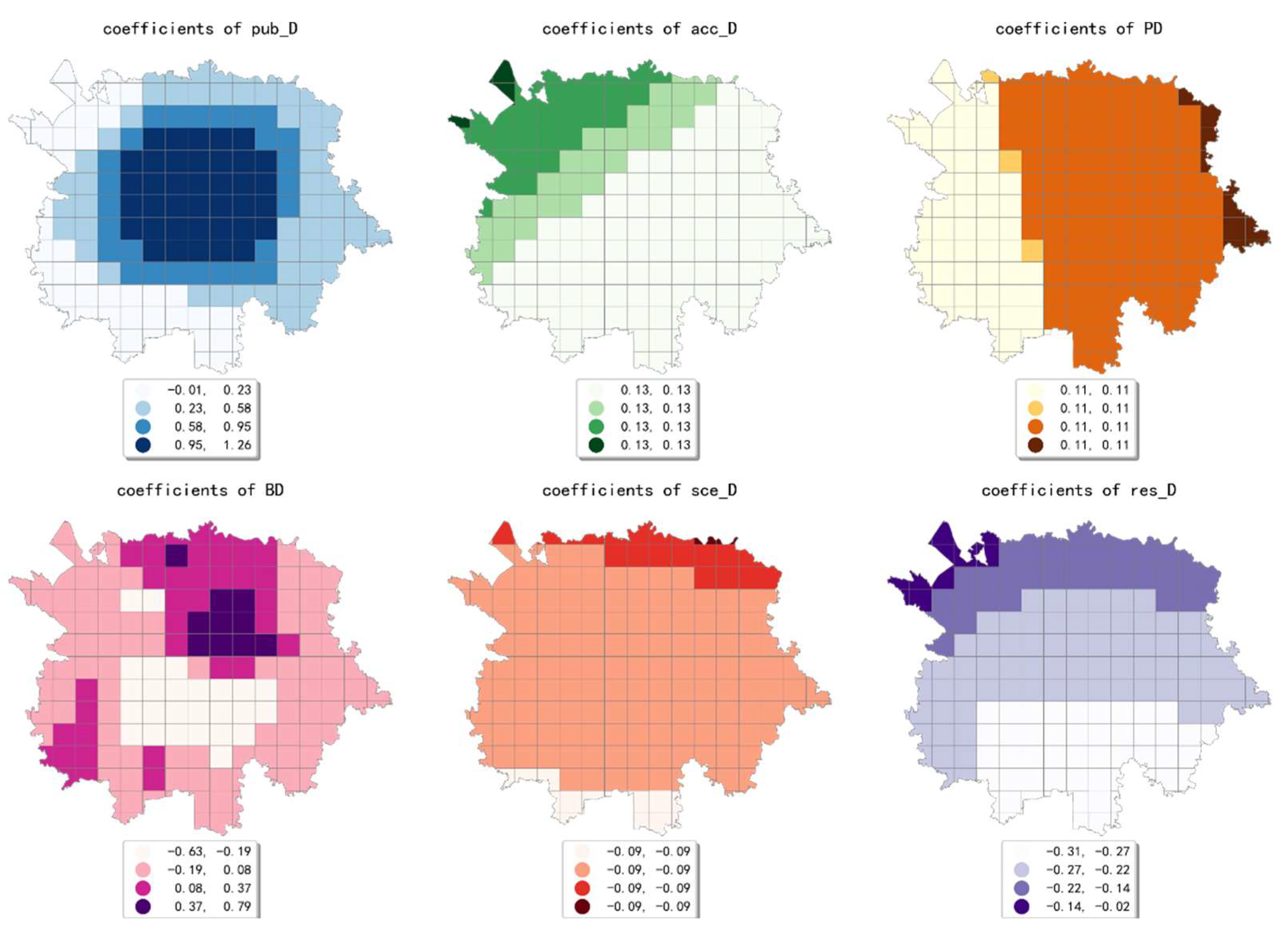
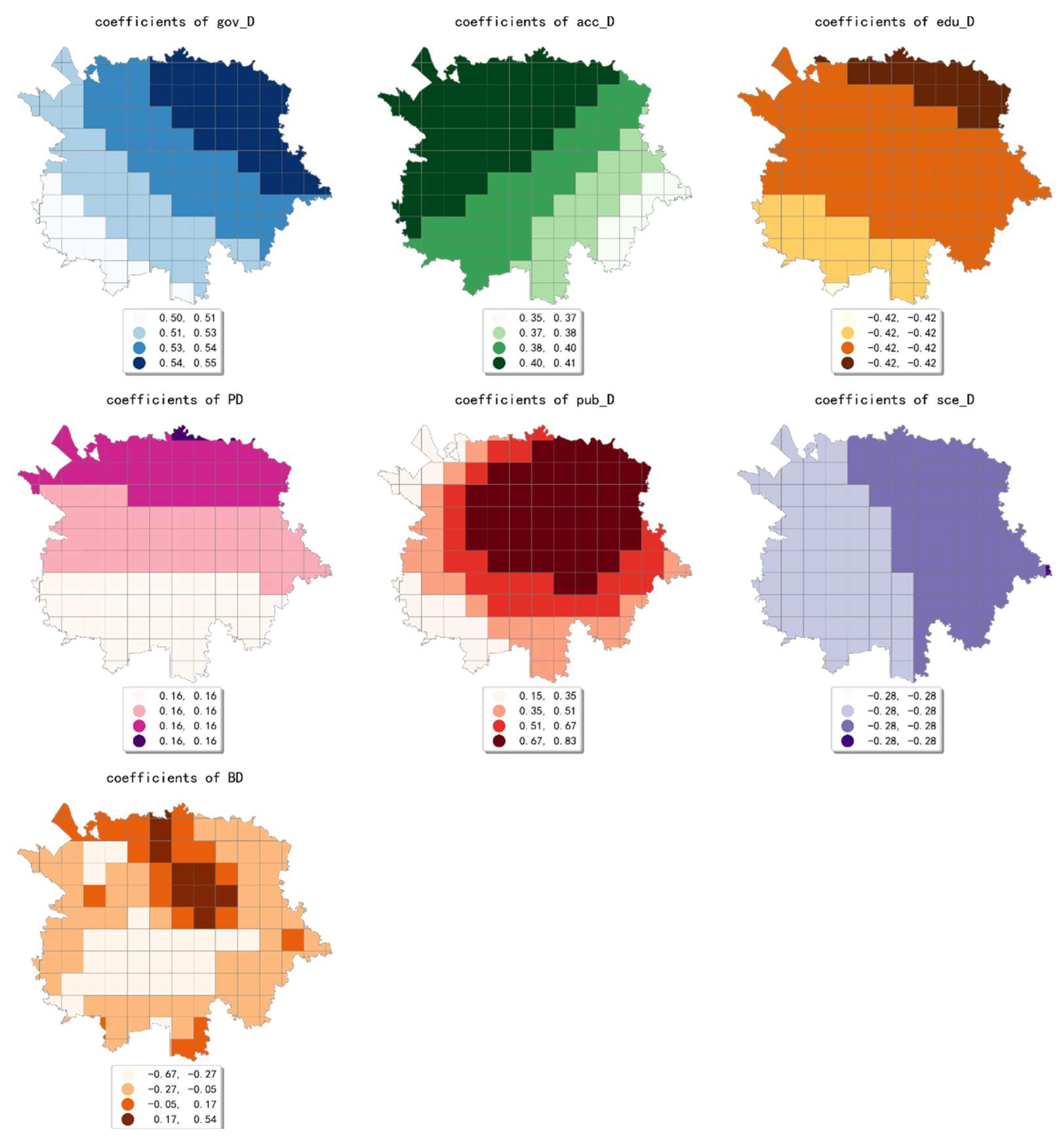
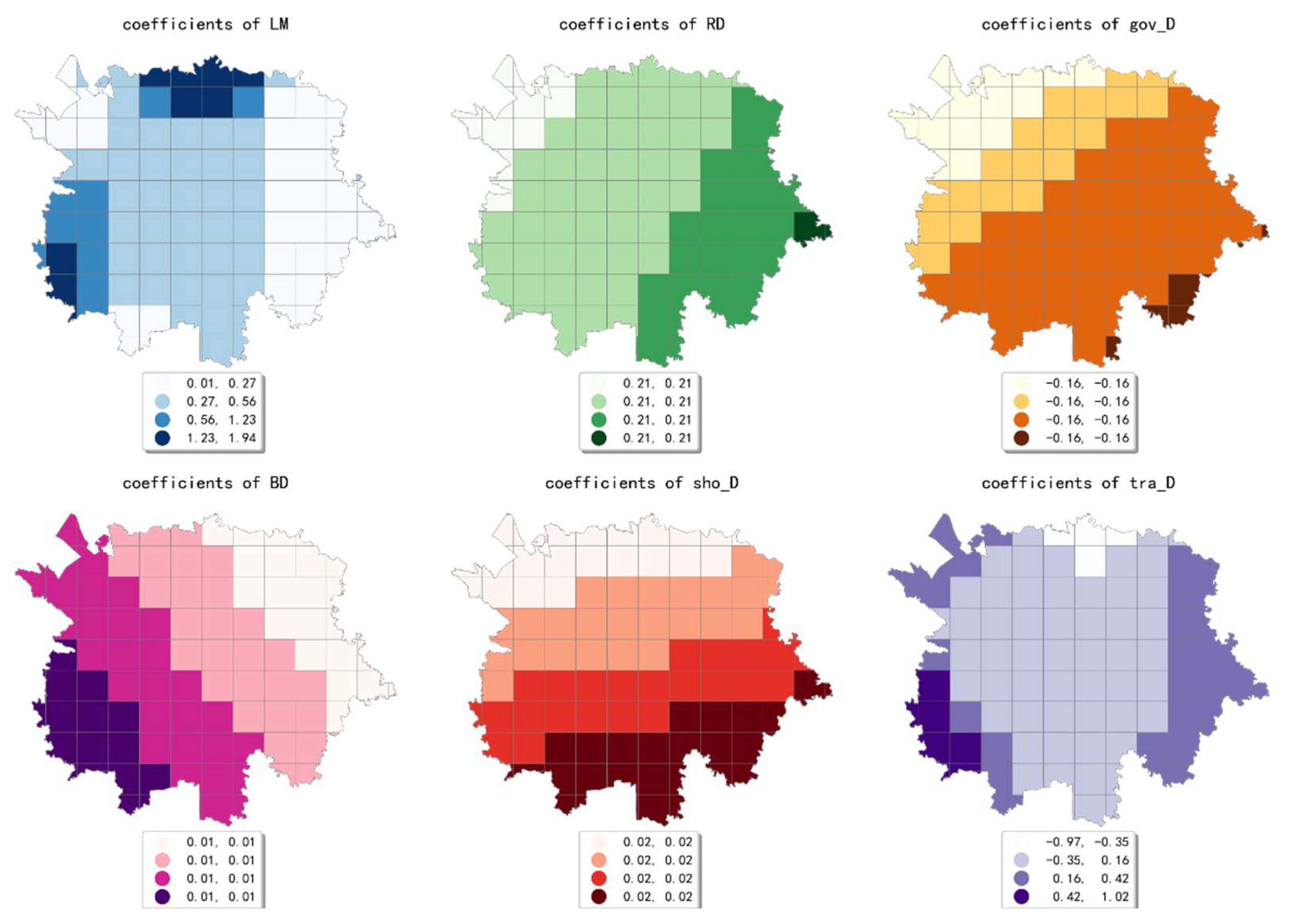
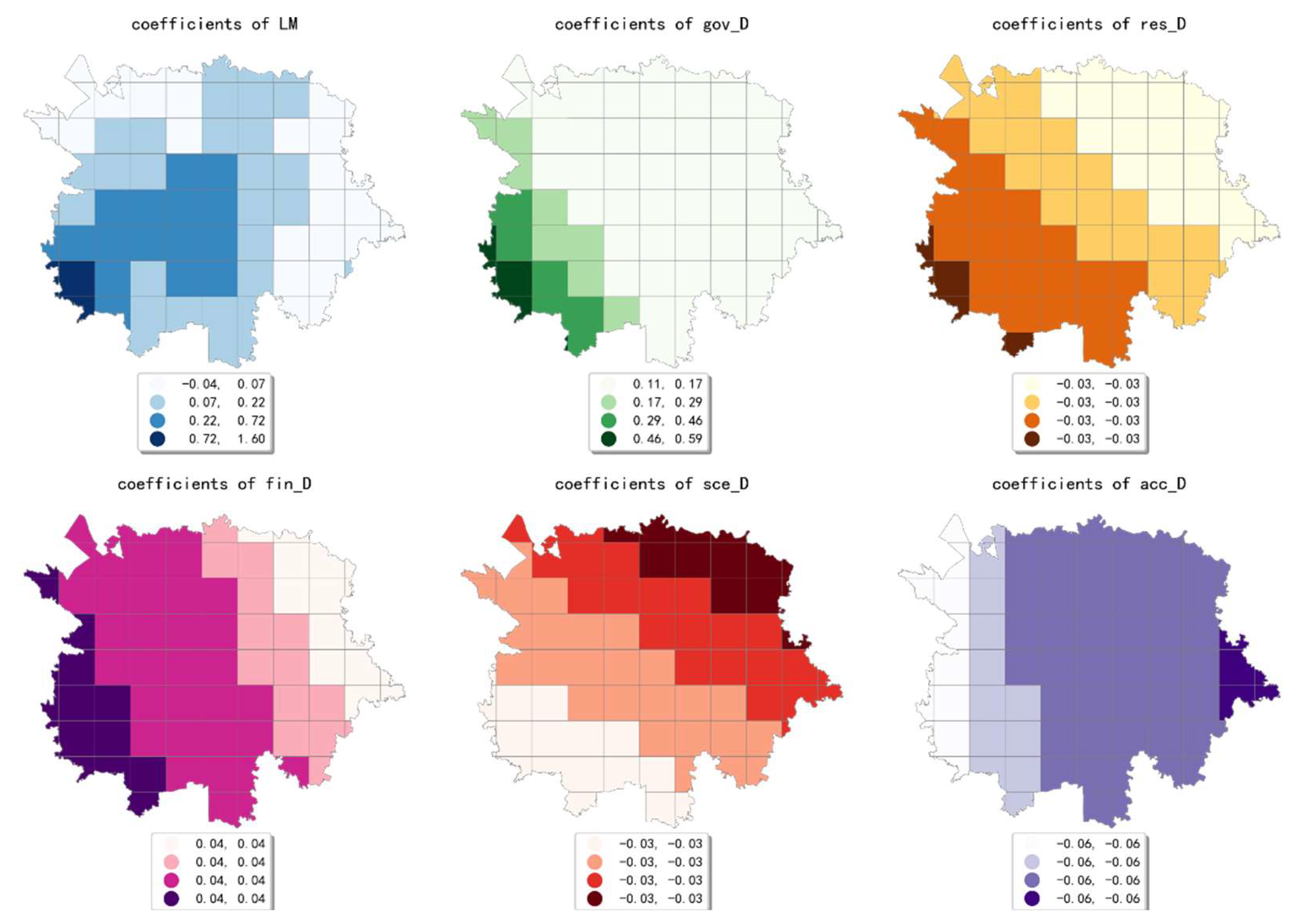
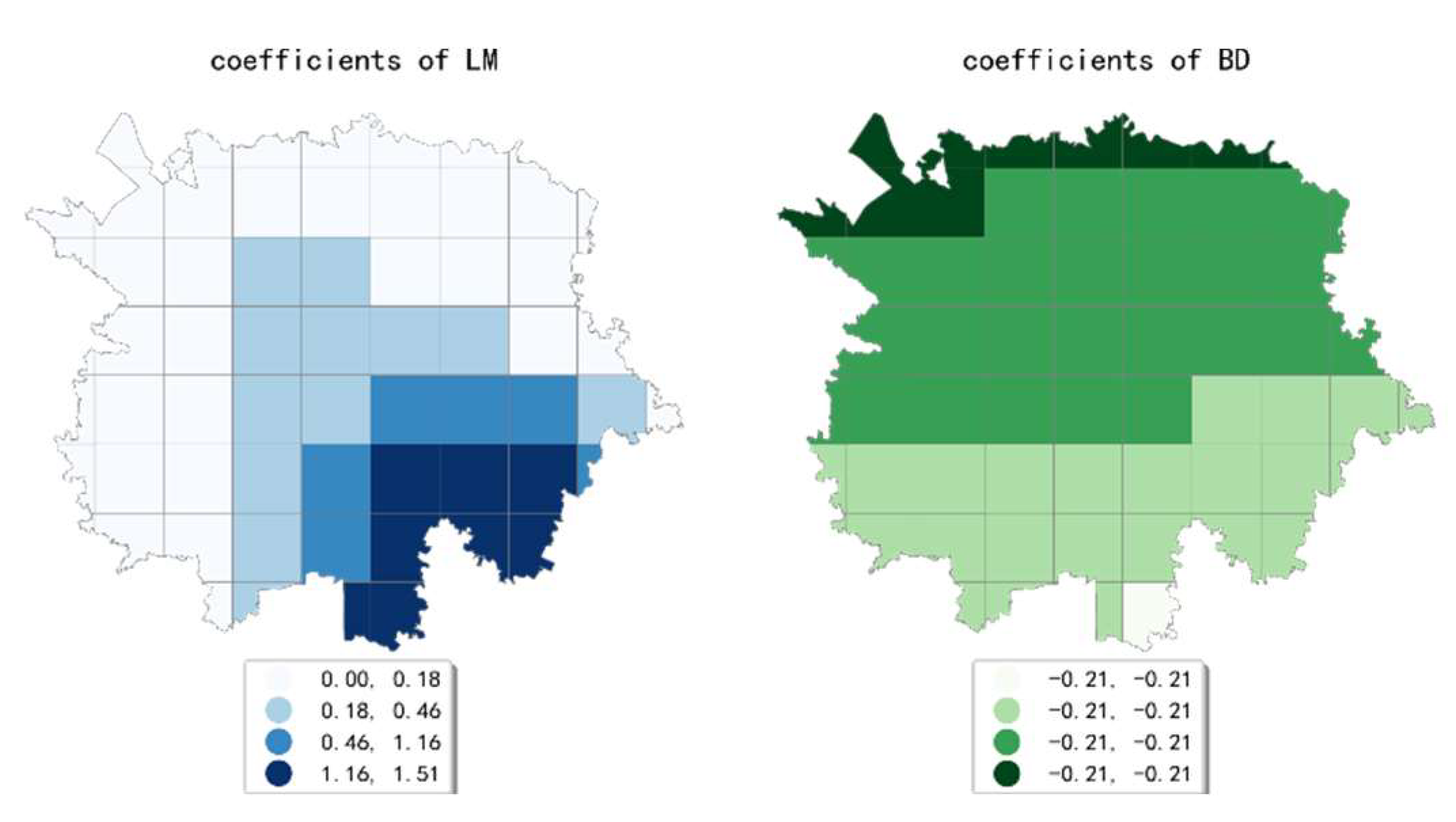
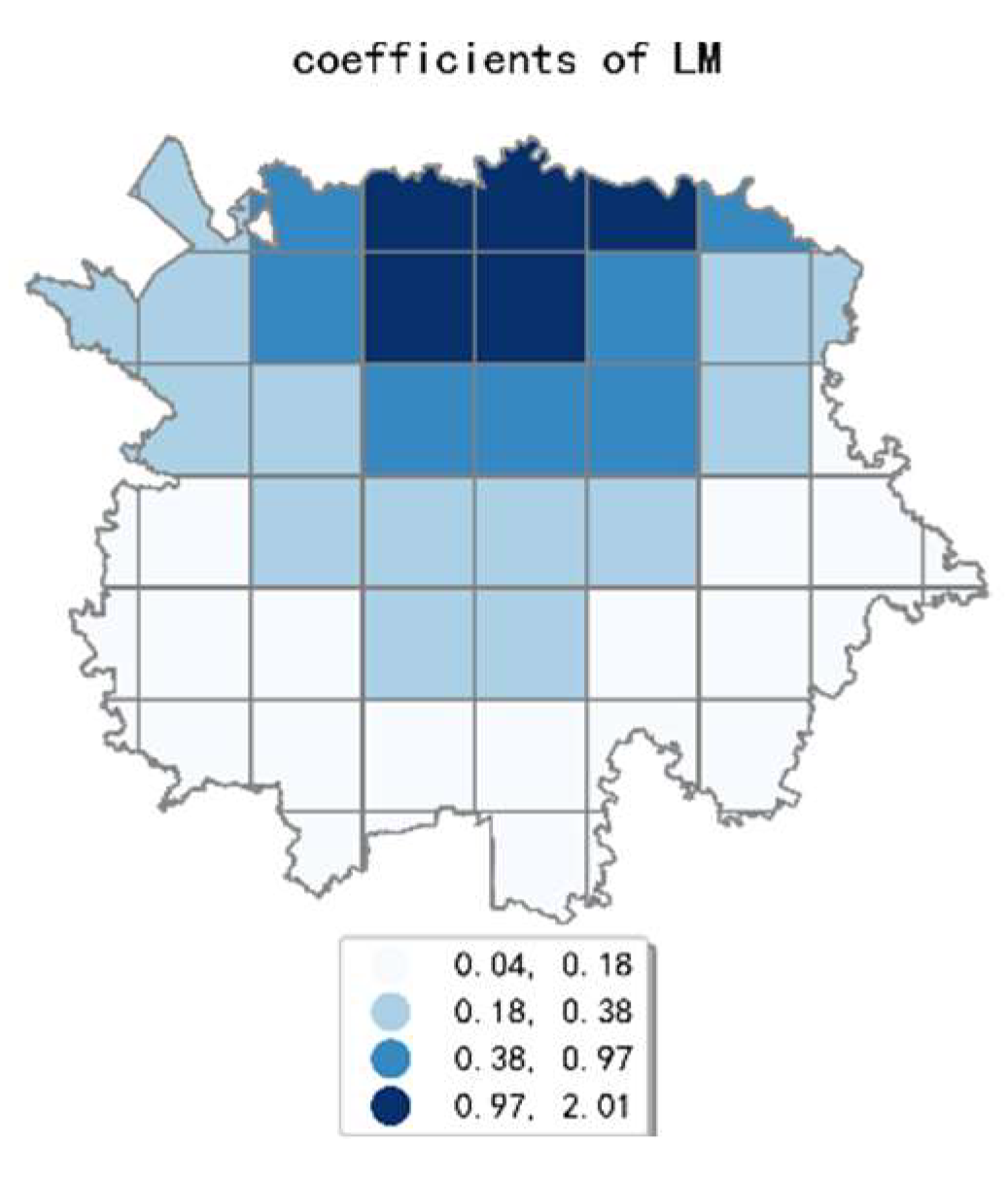
| Features | Main Indicators in Previous Literatures | Indicators in Our Study |
|---|---|---|
| density | population density, employment density | population density (PD) |
| diversity | land-use mix, job–housing imbalance | land-use mix (LM) |
| design | neighborhood, road density, etc. | road density (RD) |
| distance to transit | bus stop density, distance to metro, etc. | bus stop density (BD) |
| different land-use types | − | POI density |
| Indicators in Our Study | Abbreviations |
|---|---|
| population density | PD |
| land-use mix | LM |
| road density | RD |
| bus stop density | BD |
| catering facility density | cat_D |
| scenic spot density | sce_D |
| public service facility density | pub_D |
| company density | com_D |
| shopping facility density | sho_D |
| transportation facility density | tra_D |
| financial facility density | fin_D |
| educational, scientific, and cultural facility density | edu_D |
| residential district density | res_D |
| living service facility density | liv_D |
| sports and leisure facility density | spo_D |
| medical service facility density | med_D |
| government agency density | gov_D |
| accommodation service facility density | acc_D |
| Variables | VIF Values in Different Scales | |||||||||
|---|---|---|---|---|---|---|---|---|---|---|
| 500 m | 1000 m | 1500 m | 2000 m | 2500 m | 3000 m | 3500 m | 4000 m | 4500 m | 5000 m | |
| PD | 1.31 | 1.48 | 1.96 | 2.22 | 2.40 | 3.10 | 3.68 | 6.90 | 1.28 | 6.43 |
| RD | 1.49 | 1.93 | 1.96 | 1.78 | 2.18 | 1.28 | 5.87 | 5.65 | 2810.33 | 2.76 |
| BD | 1.74 | − | 4.14 | 5.36 | 3.53 | 4.85 | 10.41 | 9.21 | 2773.74 | − |
| LM | 1.65 | 1.44 | 1.38 | 1.33 | 1.31 | 1.65 | 2.02 | 1.80 | 2.29 | 1.61 |
| acc_D | 1.45 | 2.20 | 2.62 | 4.28 | 5.10 | 6.54 | 7.59 | 8.85 | 20.04 | 17.24 |
| cat_D | 5.22 | − | 23.32 | 28.28 | 41.87 | 48.72 | 105.02 | 111.09 | 159.23 | − |
| com_D | 1.95 | 2.76 | 3.64 | 4.65 | 4.89 | 7.26 | 9.99 | 11.40 | 14.40 | 33.39 |
| spo_D | 3.27 | 6.75 | 10.51 | 17.64 | 26.85 | 33.58 | 66.73 | 79.37 | 82.84 | 152.48 |
| gov_D | 2.05 | 3.66 | 5.86 | 9.41 | 11.55 | 26.83 | 48.56 | 6.49 | 52.51 | 84.32 |
| fin_D | 3.30 | 6.35 | 11.45 | 18.21 | 17.67 | 28.63 | 58.06 | 50.37 | 71.78 | 49.36 |
| liv_D | 5.51 | 8.60 | 17.83 | 26.38 | 43.15 | 50.57 | 77.50 | 93.28 | 191.42 | 219.01 |
| med_D | 2.55 | 4.84 | 6.43 | 10.94 | 21.78 | 21.32 | 57.37 | 44.59 | 60.18 | 178.04 |
| pub_D | 1.69 | 2.81 | 4.58 | 7.19 | 11.18 | 16.65 | 31.21 | 25.10 | 23.59 | 48.20 |
| res_D | 3.85 | 5.86 | 7.74 | 13.56 | 21.97 | 36.93 | 52.25 | 29.12 | 92.19 | 68.57 |
| sce_D | 1.21 | 1.63 | 2.10 | 3.45 | 4.21 | 7.25 | 10.50 | 10.14 | 20.67 | 20.19 |
| edu_D | 3.29 | 7.01 | 9.79 | 19.10 | 29.67 | 46.26 | 95.77 | 82.53 | 102.28 | 180.11 |
| sho_D | 2.45 | 4.82 | 9.30 | 13.79 | 19.84 | 26.89 | 57.56 | 42.83 | 52.01 | 157.12 |
| tra_D | 5.19 | 10.80 | 17.76 | 27.95 | 31.89 | 45.85 | 82.30 | 105.11 | 113.41 | 110.55 |
| Variables | Coefficients and SE in Different Scales | |||||||||
|---|---|---|---|---|---|---|---|---|---|---|
| 500 m | 1000 m | 1500 m | 2000 m | 2500 m | 3000 m | 3500 m | 4000 m | 4500 m | 5000 m | |
| PD | 0.087 (0.012) | 0.125 (0.021) | 0.164 (0.031) | 0.205 (0.038) | 0.186 (0.047) | 0.263 (0.055) | − | − | − | − |
| RD | 0.053 (0.013) | − | − | − | − | − | 0.997 (0.143) | − | − | − |
| BD | −0.034 (0.013) | − | −0.153 (0.040) | −0.183 (0.041) | −0.196 (0.051) | −0.212 (0.063) | −0.714 (0.179) | − | 0.274 (0.097) | − |
| LM | 0.075 (0.013) | 0.040 (0.040) | − | − | − | − | 0.286 (0.085) | 0.125 (0.034) | 0.569 (0.097) | 0.578 (0.110) |
| acc_D | 0.167 (0.012) | 0.306 (0.025) | 0.312 (0.036) | 0.454 (0.052) | 0.328 (0.060) | 0.515 (0.081) | − | −0.176 (0.057) | − | − |
| cat_D | − | − | − | − | − | − | − | − | − | − |
| com_D | − | − | − | − | − | − | − | − | − | − |
| spo_D | − | − | −0.129 (0.057) | −0.195 (0.060) | − | − | − | − | − | − |
| gov_D | − | − | 0.193 (0.050) | 0.391 (0.064) | − | 0.727 (0.123) | −1.192 (0.284) | 1.903 (0.067) | − | − |
| fin_D | 0.129 (0.018) | 0.156 (0.035) | − | − | − | − | − | −0.375 (0.105) | − | − |
| liv_D | − | 0.133 (0.051) | − | − | − | − | − | − | − | − |
| med_D | − | −0.125 (0.038) | − | − | − | − | − | − | − | − |
| pub_D | 0.146 (0.013) | 0.202 (0.027) | 0.251 (0.048) | 0.362 (0.067) | 0.546 (0.098) | 0.491 (0.109) | − | − | − | − |
| res_D | 0.261 (0.017) | 0.245 (0.034) | 0.208 (0.055) | − | 0.159 (0.069) | − | − | −1.035 (0.098) | − | − |
| sce_D | 0.033 (0.011) | − | −0.070 (0.032) | −0.184 (0.045) | −0.135 (0.055) | −0.281 (0.073) | − | −0.174 (0.070) | − | − |
| edu_D | 0.043 (0.017) | − | − | − | − | −0.613 (0.159) | − | − | − | − |
| sho_D | 0.103 (0.014) | 0.129 (0.038) | 0.166 (0.050) | − | − | − | 0.581 (0.261) | − | − | − |
| tra_D | 0.075 (0.023) | − | − | − | − | − | 0.764 (0.163) | − | − | − |
| Metrics | 500 m | 1000 m | 1500 m | 2000 m | 2500 m | 3000 m | 3500 m | 4000 m | 4500 m | 5000 m |
| Adj. R2 | 0.572 | 0.671 | 0.730 | 0.771 | 0.774 | 0.821 | 0.586 | 0.931 | 0.548 | 0.321 |
| AIC | 8053.725 | 1862.015 | 779.284 | 409.614 | 273.811 | 171.820 | 218.667 | 24.577 | 143.535 | 145.077 |
| RSS | 1723.607 | 348.318 | 132.847 | 65.224 | 42.660 | 24.317 | 41.410 | 5.204 | 29.374 | 37.985 |
| Moran I of Residual | 0.508 | 0.529 | 0.515 | 0.462 | 0.408 | 0.247 | 0.128 | 0.014 | 0.072 | 0.022 |
| p-value | 0.000 | 0.000 | 0.000 | 0.000 | 0.000 | 0.000 | 0.009 | 0.598 | 0.215 | 0.623 |
| Scales | Models | Adj. R2 | AIC | RSS | Bandwidth | Moran I of Residual | p-Value |
|---|---|---|---|---|---|---|---|
| 500 m | GWR | 0.922 | 2713.854 | 235.732 | 1143.620 | −0.017 | 0.033 |
| MGWR | 0.917 | 2245.675 | 281.408 | Varied 1 | −0.034 | 0.000 | |
| 1000 m | GWR | 0.946 | 515.039 | 39.678 | 1924.210 | 0.025 | 0.110 |
| MGWR | 0.967 | −140.070 | 26.100 | Varied | −0.075 | 0.000 | |
| 1500 m | GWR | 0.955 | 207.513 | 14.360 | 2466.280 | 0.061 | 0.010 |
| MGWR | 0.969 | 173.983 | 8.683 | Varied | −0.044 | 0.101 | |
| 2000 m | GWR | 0.942 | 183.366 | 11.281 | 3066.800 | 0.110 | 0.000 |
| MGWR | 0.972 | 99.093 | 4.477 | Varied | −0.021 | 0.590 | |
| 2500 m | GWR | 0.935 | 145.831 | 8.402 | 3524.190 | 0.131 | 0.000 |
| MGWR | 0.967 | 111.092 | 3.389 | Varied | −0.059 | 0.183 | |
| 3000 m | GWR | 0.923 | 109.618 | 7.868 | 5290.090 | 0.028 | 0.445 |
| MGWR | 0.957 | 39.289 | 2.941 | Varied | −0.080 | 0.139 | |
| 3500 m | GWR | 0.944 | 49.544 | 4.202 | 5862.660 | 0.013 | 0.677 |
| MGWR | 0.957 | 39.289 | 2.941 | Varied | −0.009 | 0.999 | |
| 4000 m | GWR | 0.982 | −32.981 | 0.928 | 5511.2 | −0.026 | 0.813 |
| MGWR | 0.970 | 41.006 | 1.305 | Varied | −0.047 | 0.587 | |
| 4500 m | GWR | 0.980 | −39.450 | 0.961 | 5414.45 | −0.132 | 0.032 |
| MGWR | 0.978 | −30.664 | 1.085 | Varied | −0.001 | 0.834 | |
| 5000 m | GWR | 0.973 | −16.039 | 1.103 | 5223.95 | −0.099 | 0.173 |
| MGWR | 0.981 | −20.242 | 0.712 | Varied | −0.002 | 0.850 |
Publisher’s Note: MDPI stays neutral with regard to jurisdictional claims in published maps and institutional affiliations. |
© 2022 by the authors. Licensee MDPI, Basel, Switzerland. This article is an open access article distributed under the terms and conditions of the Creative Commons Attribution (CC BY) license (https://creativecommons.org/licenses/by/4.0/).
Share and Cite
Zhao, G.; Li, Z.; Shang, Y.; Yang, M. How Does the Urban Built Environment Affect Online Car-Hailing Ridership Intensity among Different Scales? Int. J. Environ. Res. Public Health 2022, 19, 5325. https://doi.org/10.3390/ijerph19095325
Zhao G, Li Z, Shang Y, Yang M. How Does the Urban Built Environment Affect Online Car-Hailing Ridership Intensity among Different Scales? International Journal of Environmental Research and Public Health. 2022; 19(9):5325. https://doi.org/10.3390/ijerph19095325
Chicago/Turabian StyleZhao, Guanwei, Zhitao Li, Yuzhen Shang, and Muzhuang Yang. 2022. "How Does the Urban Built Environment Affect Online Car-Hailing Ridership Intensity among Different Scales?" International Journal of Environmental Research and Public Health 19, no. 9: 5325. https://doi.org/10.3390/ijerph19095325






